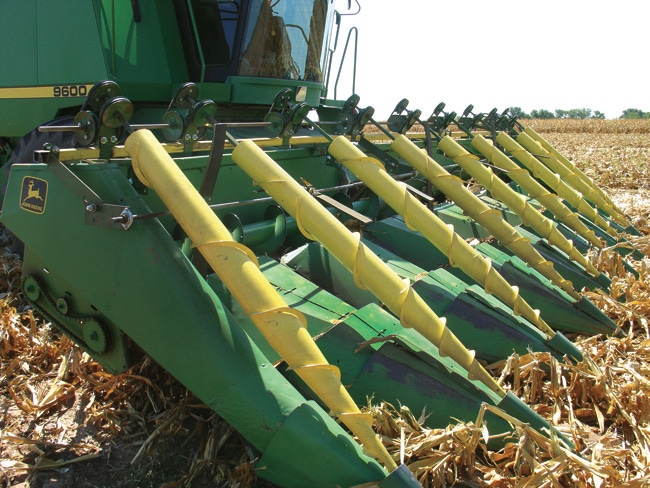August 9, 2012

It’s a problem every farmer hopes to avoid: “down” or lodged corn that cuts yields and turns harvest into an endurance trial.
In 2011 straight-line winds produced wide swaths of damage across Illinois, Iowa, Missouri, and Wisconsin, prompting some growers to wonder if lodging is becoming more common. At Kelderman Manufacturing, a builder of combine reels, Gary Kelderman believes corn lodging is an increasing problem.
“As yields go up, we can expect the incidence of corn going down to increase,” Kelderman argues. “Think of the weight of 300-bu. corn on 35,000 to 40,000 stalks or so. The higher the yield, the stronger the stalks have to be.”
Kelderman’s increased sales of equipment to manage lodged corn support his point. “We used to make sales eight to 10 months out of each year,” he says. “We’ve sold reels every month for the past 15 to 16 months.”
Many variables, from the choice of hybrid to planting conditions, or the wind direction, can affect whether corn goes down. But the biggest problem, according to Roger Elmore, Iowa State Extension (ISU) corn specialist, is that occurrences are so unpredictable.
So where can growers go for solutions?
One option to reduce risk of wind damage is seed selection. “The breeding companies have not stopped working [on standability] using higher technology tools than ever,” Elmore says. “We have a lot of information recorded for different hybrids that growers should talk to their seed dealers about.”
Another pre-planting issue is row direction. “What I’ve found is that if straight-line winds come in from the west, they are more likely to knock down rows running north and south,” he notes. “But it still depends on where the wind comes from and how good the root system is.”
Once the damage is done, growers have a couple of options: adjusting the combine and/or adding equipment to handle downed corn.
Combine adjustment
Ag agronomists and equipment experts offer a number of tips for combining in toppled corn. First, slow down and adjust the gathering chains and snapping roll speed to match the combine speed. Set the chains for more aggressive operation with points opposite each other and closer together. Then adjust deck plates so they hold stalks but not so narrow that stalks wedge between plates.
Second, operate the combine head as low as possible without picking up rocks or soil. Third, combine corn “against the grain” — opposite the direction it is leaning.
Last, fan speed may need to be reduced to avoid blowing kernels out of the combine, and rotor speed may need to be reduced to maintain grain quality.
Growers need to check behind the combine periodically for lost ears, suggests Mark Hanna, ISU agricultural engineer. “Each ¾-lb. dropped ear in 0.01 acre (about 435 sq. ft.) equals a loss of one bushel per acre,” he says. “Dropped ears hurt in two ways, first by reducing your harvested bushels per acre but also in the following year, especially in a corn-on-corn situation where a GMO trait in volunteer corn can become a weed problem.”
Harvest timing
Bob Bowman, a northeast Iowa farmer, has worked through two badly lodged crops since 2000. “The whole key is to get at it early and not worry too much about grain moisture. You need to harvest while there’s still some integrity, some residual life, in the stalks so they will hang together,” he says.
“One year I started on the downed corn, then harvested my standing corn before I came back to finish the downed corn,” he recalls. “By then the stalks had dried out and instead of feeding into the machine, they just broke off.
“Then I had an additional problem with an early snow, and that goes into the combine and plugs the machine up. I figure I put several years of wear onto my combine in just one year.”
In 2011, Bowman found that equipment advances had made his job easier. “When we strip till, we use RTK GPS autosteering to put our fertilizer right into the strip,” he says. “Last year my corn was down so bad I couldn’t see to follow the rows, so I loaded data from the RTK into the computer so the combine knew where the rows were. That way I wasn’t crossing rows. It was a huge help for the harvest and my temperament.”
Equipment options
Equipment companies offer a variety of solutions for lodged corn. A common one is a unit like the Kelderman reel, which mounts across the corn head to lift tangled stalks with a rotating series of J-shaped fingers.
Another option is the Roll-A-Cone, a series of long, slim rotating cones that mount above and in line with the snouts. The cones can be used in several configurations depending on conditions and row width.
In 2002, Goodwin Industries introduced a header sweep as an alternative to traditional corn reels. The sweep mounts above the corn head, where its drag arms pull the crop into the gathering chains.
Hawkins Manufacturing offers a reel with a system of paddles.
Manufacturers generally report their units can be mounted on all makes of combine.
About the Author(s)
You May Also Like




